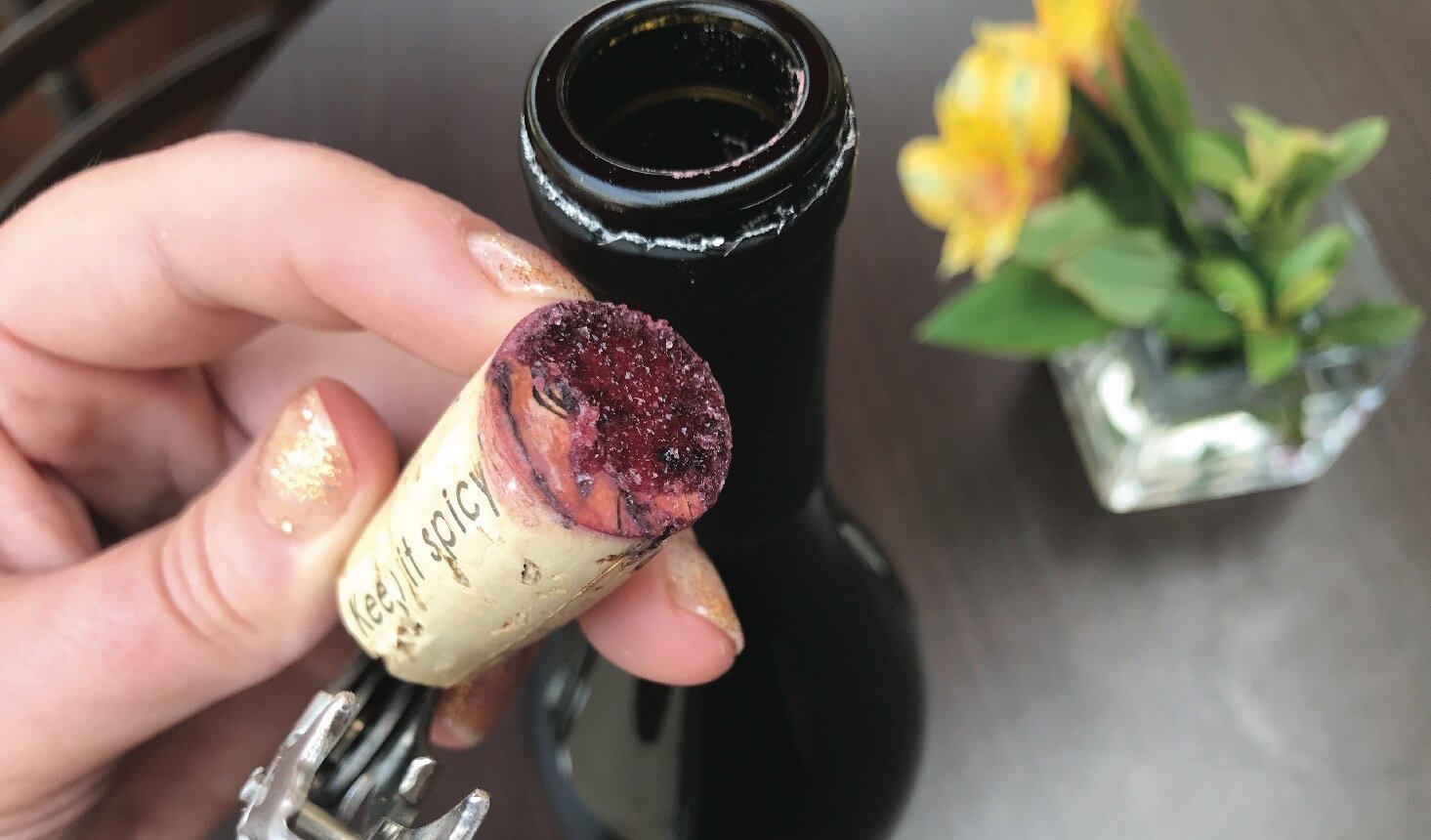I've Got Diamonds In My Glass
Why do I have crystals on my cork and diamonds in my glass?
You may have popped open a bottle recently to find sediment crystals on the top of your cork. If so, DON’T THROW AWAY THE BOTTLE! Those crystals are actually called Tartrates. They are diamonds in our wine, and we are proud of them!
You may find these Tartrates in our newest wine releases such as the 2015 Edge Red Blend or 2015 Zin Master Zinfandel or have already discovered them in some of our past wines, such as the 2015 Peter’s Delight Pinot Noir or 2014 Madame Carignane. This is because these reds are unfiltered and you will find Tartrates in most of our unfiltered red wines.
You will be relieved to know that Tartrates are actually completely safe, and in fact, are recognized as a sign of quality in a wine and winemaking. Unfiltered wines reveal signs that little to no manipulation or human intervention occurred in the cellar. They are signatures of the old-world wine making style, where wine is allowed to do what it will do with guidance of the winemaker rather than intervention or scientific manipulation. Basically, non-filtered wines are seen as a mark of a quality product and some serious wine making chops!
What exactly are Tartrates?
Ok, let’s get scientific. Tartrates are tiny crystalline stars caused by potassium and tartaric acid that bind together in wine. When those elements combine, they create potassium bitrate, which to most people (especially bakers and Snicker Doodle aficionados) is known as Cream of Tartar…. and that is what “wine diamonds” are made of.
Tartrates are part of the sediment that wines throw as they age. This is where the whole notion that well-made wines throw off sediment and tartrates. “Throwing” is when the unfiltered solids in the wine separate themselves from the juice and turn into that sludgy wine stuff on the sides or bottoms of the bottles, or both, depending on how the wine was stored. If your bottles are stored upside down, the sediment will collect in the neck of the bottle and form a cap over the juice. If stored on their side, the Tartrates will settle in the shoulder of the bottle, just below the neck – this is also sometimes called a “Badge of Honor” in wine speak and means that your wine was correctly stored on its side!
Why are there Tartrates in Spicy Vines wines and not in some of my other wines?
We’re glad you asked. Let’s start with red wines.
Some of our reds are unfiltered, which causes them to “throw off” more sediment than other wines. We choose not to filter some of our reds to keep those delicious earthy textures and rich flavors in them, which often times get stripped out of wines through a filtration process.
You also may also notice that you only see Tartrates in our red wines, but never our whites. This is because; we also don’t cold stabilize red wines like we do our whites and Rosés. Most whites and rosés are filtered and also go through cold stabilization. They kind of have to, largely for appearance sake!
What is cold stabilization?
Before whites and rosés are bottled, they are cloudy because of the solids that they carry. That’s where winemaking magic coms in, since no one wants to drink a cloudy Rosé or murky Chardonnay! At Spicy Vines, we cold stabilize all of our whites and Rosés, which is why you will never find crystals in either.
Cold stabilization is the process of dropping the temperature of a wine to just below freezing and keeping it there for 10 days (+ or -) in stainless steel tanks. Cold stabilization speeds up the creation of Tartrates through the formation of solids in the wines when cooled. These solids bind and then simply “drop out” or separate themselves from the juice.
Cold stabilizing white wines can be a bit tricky though, as with reds, the solids in whites give off rich flavors and aromas to their wines. If cold stabilization is overdone (like it is with lower end and bulk type wines), the wines will be stripped of what gives them all those beautiful smells, tastes and finesse. This is where attention to detail, intuition, knowledge, and experience work respectfully with Mother Nature to clear up the clouds while extracting those beautiful flavors desired in these wines.
All whites and Rosés go through different refining, filtering, and cold stabilizing processes depending on the winemaker. You may find sediment in some of your whites of Rosés made by other winemakers, meaning they were not cold stabilized. Sometimes when whites or Rosés are stored in a refrigerator, they will get cold enough for potassium and tartaric acid remaining in the wine to bond forming Tartrates. This will also happen wines are stored for extended period of time in the refrigerator.
Dealing with tartrates and sediment is easy peasy!
If you can pull a wine that has been stored on its side or upside down out a couple days before drinking it, do so. Just stand it up on the counter and let gravity take over. When you open the bottle, wipe off the cork and the mouth so that sediment doesn’t get all over things. From there, gently pour the wine at an angle. This will keep the sediment on the side or bottom of the bottle, and that last bit can even be run through a coffee filter, specially one of the gold mesh ones or a very fine gauge strainer will do. You can also decant the wine. Or, just pour it.
You can avoid this by refrigerating your whites and Rosés as needed, and not leaving them in your kitchen fridge for several weeks. You can also get a mini-fridge or a wine fridge where you can control the temperature.
Hopefully, this clears things up. If it hasn’t, please give us a call or send us an email, and one of us will be happy to answer your questions.
As always, thank you for loving Spicy Vines!


